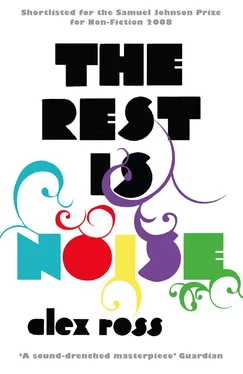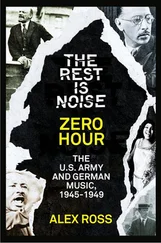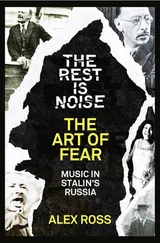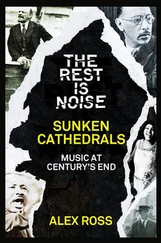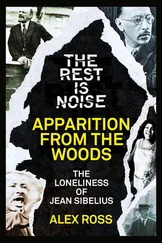The proximity of such renowned figures as Schoenberg and Stravinsky had encouraged Mann to write a “novel of music,” in which a modern composer produces esoteric masterpieces and then descends into syphilitic insanity. For advice, Mann turned to Theodor W. Adorno, who had studied with Schoenberg’s pupil Alban Berg and who was also part of the Los Angeles émigré community.
Mann self-confessedly approached modern music from the perspective of an informed amateur who wondered what had happened to the “lost paradise” of German Romanticism. Mann had attended the premiere of Mahler’s Eighth in 1910. He had briefly met Mahler, and trembled in awe before him. Some three decades later, Mann watched as Schoenberg, Mahler’s protégé, presented his “extremely difficult” but “rewarding” scores to small groups of devotees in Los Angeles. The novel asks, in so many words, “What went wrong?”
Leverkühn is an intellectual monster—cold, loveless, arrogant, mocking. His music absorbs all styles of the past and shatters them into fragments. “I have found that it is not to be,” he says of Beethoven’s Ninth Symphony, whose “Ode to Joy” once spoke for mankind’s aspiration toward brotherhood. “It will be taken back. I will take it back.” The illness that destroys Leverkühn is acquired in a curious way. He tells his friends that he is going to see the Austrian premiere of Salome in Graz. On a secret detour he sleeps with a prostitute named Esmeralda, whose syphilitic condition is visible on her yellowed face. Leverkühn contracts the disease deliberately, in the belief that it will grant him supernatural creative powers. When the devil appears, he informs the composer that he will never be popular in his lifetime but that his time will come, à la Mahler: “You will lead, you will strike up the march of the future, boys will swear by your name, and thanks to your madness they will no longer need to be mad.” Since Faustus is also a book about the roots of Nazism, Leverkühn’s “bloodless intellectuality” becomes, in a cryptic way, the mirror image of Hitler’s “bloody barbarism.” The cultish fanaticism of modern art turns out to be not unrelated to the politics of fascism: both attempt to remake the world in utopian forms.
Schoenberg was understandably incensed by this scenario, which gave a pathological veneer to his proudest achievements. The real-life composer could be a bit spooky at times—“I can see through walls,” he was once heard to say—but he was hardly a cold or bloodless man. He set about revolutionizing music with high passion and childlike enthusiasm. As a born Viennese who venerated the Austro-German tradition, he could never have mocked Beethoven’s Ninth. As a Jew, he divined the true nature of Nazism sooner than did Mann. Aloofness was not his style; he was, among other things, a galvanizing, life-changing teacher, dozens of whose students, from the operatic Berg to the aphoristic Anton Webern, from the Communist Hanns Eisler to the hippieish Lou Harrison, played conspicuous roles in twentieth-century music.
Yet Mann knew what he was doing when he put his composer in league with the devil. Faust’s pact is a lurid version of the kinds of stories that artists tell themselves in order to justify their solitude. Eisler, when he read Mann’s novel, connected it to the perceived crisis of classical music in modern society. “Great art, as the Devil maintains, can now only be produced, in this declining society, through complete isolation, loneliness, through complete heartlessness … [Yet Mann] allows Leverkühn to dream of a new time, when music will again to a certain extent be on first-name terms with the people.” Other composers of the fin de siècle similarly conceived their situation as a one-man fight against a crude and stupid world. Claude Debussy, in Paris, assumed an antipopulist stance in the years before 1900 and not coincidentally broke away from conventional tonality in the same period. But Schoenberg took the most drastic steps, and perhaps more important, he set forth an elaborate teleology of musical history, a theory of irreversible progress, to justify his actions. The Faust metaphor honors the dread that Schoenberg’s juggernaut inspired in early listeners.
At the beginning of the twenty-first century, Schoenberg’s music no longer sounds so alien. It has radiated outward in unpredictable ways, finding alternative destinies in bebop jazz (the glassy chords of Thelonious Monk have a Schoenbergian tinge) and on movie soundtracks (horror movies need atonality as they need shadows on the walls of alleys). With the modernist revolution splintered into many factions, with composers gravitating back to tonality or moving on to something else, Schoenberg’s music no longer carries the threat that all music will sound like this. Still, it retains its Faustian aura. These intervals will always shake the air; they will never become second nature. That is at once their power and their fate.
Vienna 1900
In his early stories Thomas Mann produced several lively portraits of a widespread turn-of-the-century type, the apocalyptic aesthete. The story “At the Prophet’s,” written in 1904, begins with an ironic ode to artistic megalomania:
Strange regions there are, strange minds, strange realms of the spirit, lofty and spare. At the edge of large cities, where street lamps are scarce and policemen walk by twos, are houses where you mount til you can mount no further, up and up into attics under the roof, where pale young geniuses, criminals of the dream, sit with folded arms and brood; up into cheap studios with symbolic decorations, where solitary and rebellious artists, inwardly consumed, hungry and proud, wrestle in a fog of cigarette smoke with devastatingly ultimate ideals. Here is the end: ice, chastity, null. Here is valid no compromise, no concession, no half-way, no consideration of values. Here the air is so rarefied that the mirages of life no longer exist. Here reign defiance and iron consistency, the ego supreme amid despair; here freedom, madness, and death hold sway.
In Mann’s 1902 story “Gladius Dei,” a young man named Hieronymus strides through Richard Strauss’s hometown of Munich, scowling at the extravagance around him. He goes inside an art shop and berates its owner for displaying kitsch—art that is merely “beautiful” and therefore worthless. “Do you think gaudy colors can gloss over the misery of the world?” Hieronymus shouts. “Do you think loud orgies of luxurious good taste can drown the moans of the tortured earth? … Art is the sacred torch that must shed its merciful light into all life’s terrible depths, into every shameful and sorrowful abyss; art is the divine flame that must set fire to the world, until the world with all its infamy and anguish burns and melts away in redeeming compassion!”
All over fin-de-siècle Europe, strange young men were tramping up narrow stairs to garret rooms and opening doors to secret places. Occult and mystical societies—Theosophist, Rosicrucian, Swedenborgian, kabbalistic, and neopagan—promised rupture from the world of the present. In the political sphere, Communists, anarchists, and ultranationalists plotted from various angles to overthrow the quasi-liberal monarchies of Europe; Leon Trotsky, in exile in Vienna from 1907 to 1914, began publishing a paper called Pravda. In the nascent field of psychology, Freud placed the ego at the mercy of the id. The world was unstable, and it seemed that one colossal Idea, or, failing that, one well-placed bomb, could bring it tumbling down. There was an almost titillating sense of imminent catastrophe.
Vienna was the scene of what may have been the ultimate pitched battle between the bourgeoisie and the avant-garde. A minority of “truth-seekers,” as the historian Carl Schorske calls them, or “critical modernists,” in the parlance of the philosopher Allan Janik, grew incensed by the city’s rampant aestheticism, its habit of covering all available surfaces in gold leaf. They saw before them a supposedly modern, liberal, tolerant society that was failing to deliver on its promises, that was consigning large parts of its citizenry to poverty and misery. They spoke up for the outcasts and the scapegoats, the homosexuals and the prostitutes. Many of the “truth-seekers” were Jewish, and they were beginning to comprehend that Jews could never assimilate themselves into an anti-Semitic society, no matter how great their devotion to German culture. In the face of the gigantic lie of the cult of beauty—so the rhetoric went—art had to become negative, critical. It had to differentiate itself from the pluralism of bourgeois culture, which, as Salome demonstrated, had acquired its own avant-garde division.
Читать дальше
